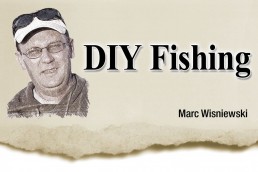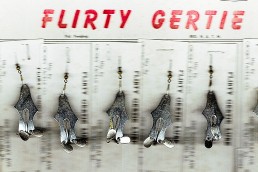Midwest Finesse Jig: New jigs from Do-it the basis for light tackle system
SHARE THIS POST
There is a sign on fire extinguisher cabinets that say, “in case of fire, break glass.” For many years, that’s what I thought about the Midwest finesse bass system. When all else failed, I would break out the Midwest finesse rig, or the “goose turd” as I have always called it, and catch fish when nothing else worked.
Many years ago I thought to myself: Why do I only bring this out when other tactics aren’t working? This is so effective, why aren’t I fishing this all the time? Since then, I never go anywhere without at least some “goose turds,” and in most cases, a rod specifically set up for this.
The basis for this system is a special jig head that resembles the shape of a mushroom. Until now, I’ve used the Do-it Worm Nose jig head. It’s still a great head, but this year Do-it has made many finesse fishermen very happy by releasing their new Midwest Finesse Jig Head.
The model MFJ-6-A features a perfectly designed mushroom cap head in six sizes, from 1/16 to 1/4 ounce. This variety covers all light tackle finesse presentations, from shallow gravel flats to deep points or breaklines. Since this system is somewhat dressing-specific, the hook doesn’t need to vary from the biggest to the smallest size heads. In the case of the Midwest Finesse, the mold accepts sizes 1 and 1/0 hooks. So whether you’re making the 1/16, 1/4, or anything in between, the same size hook can be used, and there’s no need to sacrifice hook size to make the lighter versions.
This mold was designed to use the strong light wire Owner 5313 jig hook. It really is a perfect hook for this jig, combining the light wire for easy hook-sets with light tackle, and has the strength to land big fish. But if you have a favorite hook, don’t fret. Many other standard 90-degree bend hooks will also fit into this mold. Another good choice is a Matzuo Sickle hook, which I have used for many years. The 1/0 size is my personal favorite.
The other feature of the mold is the ability to add the j-hook plastic keeper to the head. With the old Worm Nose head Jig there is a barbed collar, which works well, but sometimes splits thin plastic tails. That problem is solved with the wire keeper. The thin wire won’t split the plastic and will keep the bait securely anchored to the head. This really helps when making long casts to shallow, spooky fish.
For the Midwest finesse system, this is finesse fishing at its finest. As I mentioned, I used to rely on this system to tackle the tough days. Before I had wondered: If it catches fish on the slow days, just think what would it do on a good day. And I was right. When they are really hitting, sometimes this bait doesn’t even get to the bottom before it gets eaten. It’s not fast fishing, but it’s thorough fishing. If I work an area with a Midwest finesse rig and don’t get a bite, I’m pretty sure that there is nothing there.
The tackle is a light-spinning rod and a reel loaded with either light braid with an 8-foot mono leader, or in my case, 6-pound-test fluorocarbon line. The rod can’t be an ultra-light or a buggy whip, but should have a light tip to flick the small lures long distances and some guts in the butt to set the hook and land a big fish. I like a 7-foot, medium-light with an extra-fast tip.
Are you enjoying this post?
You can be among the first to get the latest info on where to go, what to use and how to use it!
The basics for the classic Midwest finesse rig is the Do-it Midwest Finesse Jig Head matched with a half of a stick-type worm like a Senko. Half of a 5-inch worm gets you a 2 1/2-inch lure. At times, the fish want it even smaller and you may need to cut it down to 2 inches or less. It doesn’t look like much, but in the fish’s world it looks like everything—grubs, emerging bugs, small crawfish, minnows, gobies and who knows what other creepy crawly things on the bottom of a lake. All I know is that its small profile represents something that is non-intimidating, and an easy target for any gamefish.
If you really want to get crafty, Do-it has an Essential Series mold that is very reasonable that makes a true 5-inch Senko to spec. In this case, you can make any color you want. If you need a starting point, it’s hard to beat a watermelon color or a smoke with some red flake.
This is a bass system; largemouths love it and smallmouths love it even more. That said I catch a ton of walleyes on it as well as many pike by accident. Lake Michigan browns, lake trout and steelhead think it’s a perfect imitation for a goby. I’ve caught bass in central Florida with this system too. I’ve poured pearl worms and used them as baitfish imitations for Lake Michigan trout and for the saltwater species in the Gulf. It’s going to become your go-to for so many species that you won’t be caught without a selection along, no matter where you fish.
You may believe this bait and system can’t possibly have any action because it has a 2 1/2-inch pointed chunk of plastic with a blunt head jig. But you have to see this bait in the water—it reacts with the slightest movement of your hand, your line, the wind, etc. It never stops twitching and acting erratically. And, the less you try to add action, the better it works.
The most common system is to cast it out and let it sink to the bottom. Then shake the line a little and wait a couple seconds. Lift the jig a foot or two and let it settle, and repeat. You will see the line jump or feel that telltale thump when a fish eats it. It’s an exposed hook, so hook-ups are simple and nearly at a 100 percent rate.
My favorite method is a little different. I like to cast the jig out and let it get to the bottom. Then I’ll start reeling slowly, one- half to 1 turn of the reel at a time. I want that jig to be swimming just above the bottom. Pause now and then if you feel like it needs to reestablish the bottom. Use the lightest jig you can get away with to remain in control of the bait. When it’s perfect it will feel like the jig is dangling in space, as if it’s there but you can hardly feel anything. If you have to speed up your retrieve to keep it off the bottom, the jig is too heavy, go lighter. If the wind is playing havoc and you are having trouble staying near the bottom then you’re too light, go a little heavier. But with six sizes at your disposal, you will have the correct size for any situation. The natural sinking qualities of fluorocarbon are perfect for this system and allow you to go lighter on the jig and still work some deep water.
Beyond the half of a stick worm, small creature baits are also a good choice for this system. My absolute favorite is the Do-it McGrady “Newt,” which is a mini, 3-inch creature that bass and walleyes love.
If you are already a hardcore Midwest finesse fan, this new Do-it Midwest Finesse Jig is what you have been waiting for. If you haven’t tried this system yet, you need to put it on your agenda for this season. From ice-out until late fall, this tactic catches bass, walleyes and trout under nearly every condition. Even if you are generally a power fisherman, you’ll need this tactic in your arsenal. Midwest finesse will save many a tough fishing trip for you. And as always, it’s so much fun to catch a fish on a lure you made yourself.
MWO
SHARE THIS POST
Did you enjoy this post?
You can be among the first to get the latest info on where to go, what to use and how to use it!
Marc Wisniewski
Marc Wisniewski is an avid Wisconsin angler specializing in Lake Michigan shore and inshore fishing. He also chases bass, pike, and muskies anywhere he can. He has built custom rods for 35 years and makes lures from wood, lead and soft plastics. Wisniewski has been writing fishing articles for more than 30 years.



